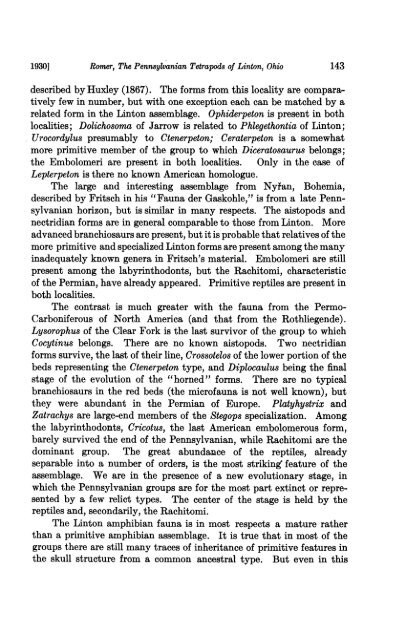View/Open - American Museum of Natural History
View/Open - American Museum of Natural History
View/Open - American Museum of Natural History
Create successful ePaper yourself
Turn your PDF publications into a flip-book with our unique Google optimized e-Paper software.
1930] Romer, The Pennsylvanian Tetrapods <strong>of</strong> Linton, Ohio<br />
143<br />
described by Huxley (1867). The forms from this locality are comparatively<br />
few in number, but with one exception each can be matched by a<br />
related form in the Linton assemblage. Ophiderpeton is present in both<br />
localities; Dolichosoma <strong>of</strong> Jarrow is related to Phlegethontia <strong>of</strong> Linton;<br />
Urocordylus presumably to Ctenerpeton; Ceraterpeton is a somewhat<br />
more primitive member <strong>of</strong> the group to which Diceratosaurus belongs;<br />
the Embolomeri are present in both localities. Only in the case <strong>of</strong><br />
Lepterpeton is there no known <strong>American</strong> homologue.<br />
The large and interesting assemblage from Nyfan, Bohemia,<br />
described by Fritsch in his "Fauna der Gaskohle," is from a late Pennsylvanian<br />
horizon, but is similar in many respects. The aistopods and<br />
nectridian forms are in general comparable to those from Linton. More<br />
advanced branchiosaurs are present, but it is probable that relatives <strong>of</strong> the<br />
more primitive and specialized Linton forms are present among the many<br />
inadequately known genera in Fritsch's material. Embolomeri are still<br />
present among the labyrinthodonts, but the Rachitomi, characteristic<br />
<strong>of</strong> the Permian, have already appeared. Primitive reptiles are present in<br />
both localities.<br />
The contrast is much greater with the fauna from the Permo-<br />
Carboniferous <strong>of</strong> North America (and that from the Rothliegende).<br />
Lysorophus <strong>of</strong> the Clear Fork is the last survivor <strong>of</strong> the group to which<br />
Cocytinus belongs. There are no known aistopods. Two nectridian<br />
forms survive, the last <strong>of</strong> their line, Crossotelos <strong>of</strong> the lower portion <strong>of</strong> the<br />
beds representing the Ctenerpeton type, and Diplocaulus being the final<br />
stage <strong>of</strong> the evolution <strong>of</strong> the "horned" forms. There are no typical<br />
branchiosaurs in the red beds (the micr<strong>of</strong>auna is not well known), but<br />
they were abundant in the Permian <strong>of</strong> Europe. Platyhystrix and<br />
Zatrachys are large-end members <strong>of</strong> the Stegops specialization. Among<br />
the labyrinthodonts, Cricotus, the last <strong>American</strong> embolomerous form,<br />
barely survived the end <strong>of</strong> the Pennsylvanian, while Rachitomi are the<br />
dominant group. The great abundance <strong>of</strong> the reptiles, already<br />
separable into a number <strong>of</strong> orders, is the most strikingl feature <strong>of</strong> the<br />
assemblage. We are in the presence <strong>of</strong> a new evolutionary stage, in<br />
which the Pennsylvanian groups are for the most part extinct or represented<br />
by a few relict types. The center <strong>of</strong> the stage is held by the<br />
reptiles and, secondarily, the Rachitomi.<br />
The Linton amphibian fauna is in most respects a mature rather<br />
than a primitive amphibian assemblage. It is true that in most <strong>of</strong> the<br />
groups there are still many traces <strong>of</strong> inheritance <strong>of</strong> primitive features in<br />
the skull structure from a common ancestral type. But even in this
















